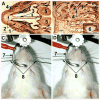Dorsorostral snout muscles in the rat subserve coordinated movement for whisking and sniffing
- PMID: 22641389
- PMCID: PMC4153473
- DOI: 10.1002/ar.22501
Dorsorostral snout muscles in the rat subserve coordinated movement for whisking and sniffing
Abstract
Histochemical examination of the dorsorostral quadrant of the rat snout revealed superficial and deep muscles that are involved in whisking, sniffing, and airflow control. The part of M. nasolabialis profundus that acts as an intrinsic (follicular) muscle to facilitate protraction and translation of the vibrissae is described. An intraturbinate and selected rostral-most nasal muscles that can influence major routs of inspiratory airflow and rhinarial touch through their control of nostril configuration, atrioturbinate and rhinarium position, were revealed.
Copyright © 2012 Wiley Periodicals, Inc.
Figures














Similar articles
-
The Musculature That Drives Active Touch by Vibrissae and Nose in Mice.Anat Rec (Hoboken). 2015 Jul;298(7):1347-58. doi: 10.1002/ar.23102. Epub 2014 Dec 5. Anat Rec (Hoboken). 2015. PMID: 25408106 Free PMC article.
-
Rhythmic whisking by rat: retraction as well as protraction of the vibrissae is under active muscular control.J Neurophysiol. 2003 Jan;89(1):104-17. doi: 10.1152/jn.00600.2002. J Neurophysiol. 2003. PMID: 12522163
-
Biomechanics of the vibrissa motor plant in rat: rhythmic whisking consists of triphasic neuromuscular activity.J Neurosci. 2008 Mar 26;28(13):3438-55. doi: 10.1523/JNEUROSCI.5008-07.2008. J Neurosci. 2008. PMID: 18367610 Free PMC article.
-
Circuits in the Ventral Medulla That Phase-Lock Motoneurons for Coordinated Sniffing and Whisking.Neural Plast. 2016;2016:7493048. doi: 10.1155/2016/7493048. Epub 2016 May 18. Neural Plast. 2016. PMID: 27293905 Free PMC article. Review.
-
Sniffing and whisking in rodents.Curr Opin Neurobiol. 2012 Apr;22(2):243-50. doi: 10.1016/j.conb.2011.11.013. Epub 2011 Dec 15. Curr Opin Neurobiol. 2012. PMID: 22177596 Free PMC article. Review.
Cited by
-
Mediation of muscular control of rhinarial motility in rats by the nasal cartilaginous skeleton.Anat Rec (Hoboken). 2013 Dec;296(12):1821-32. doi: 10.1002/ar.22822. Epub 2013 Oct 29. Anat Rec (Hoboken). 2013. PMID: 24249396 Free PMC article.
-
Tactile modulation of whisking via the brainstem loop: statechart modeling and experimental validation.PLoS One. 2013 Nov 27;8(11):e79831. doi: 10.1371/journal.pone.0079831. eCollection 2013. PLoS One. 2013. PMID: 24312186 Free PMC article.
-
Muscles involved in naris dilation and nose motion in rat.Anat Rec (Hoboken). 2015 Mar;298(3):546-53. doi: 10.1002/ar.23053. Epub 2014 Oct 3. Anat Rec (Hoboken). 2015. PMID: 25257748 Free PMC article.
-
Evidence for Functional Groupings of Vibrissae across the Rodent Mystacial Pad.PLoS Comput Biol. 2016 Jan 8;12(1):e1004109. doi: 10.1371/journal.pcbi.1004109. eCollection 2016 Jan. PLoS Comput Biol. 2016. PMID: 26745501 Free PMC article.
-
How the brainstem controls orofacial behaviors comprised of rhythmic actions.Trends Neurosci. 2014 Jul;37(7):370-80. doi: 10.1016/j.tins.2014.05.001. Epub 2014 Jun 2. Trends Neurosci. 2014. PMID: 24890196 Free PMC article. Review.
References
-
- Ahissar E, Knutsen PM. Object localization with whiskers. Biol Cybern. 2008;98:449–458. - PubMed
-
- Bahar A, Dudai Y, Ahissar E. Neural signature of taste familiarity in the gustatory cortex of the freely behaving rat. J Neurophysiol. 2004;92:3298–3308. - PubMed
-
- Banke J, Mess A, Zeller U. Functional morphology of the rostral head region of Cryptomys hottentotus (Bathyergidae, Rodentia) Proceedings of the 8th International Symposium on African Small Mammals. 2001:231–241.
-
- Berg RW, Kleinfeld D. Rhythmic whisking by rat: retraction as well as protraction of the vibrissae is under active muscular control. J Neurophysiol. 2003;89:104–117. - PubMed
-
- Bermejo R, Friedman W, Zeigler HP. Topography of whisking II: Interaction of whisker and pad. Somatosens Mot Res. 2005;22:213–220. - PubMed
Publication types
MeSH terms
Grants and funding
LinkOut - more resources
Full Text Sources

